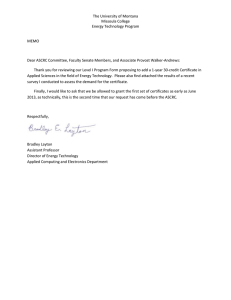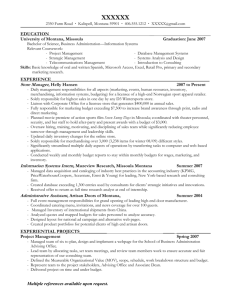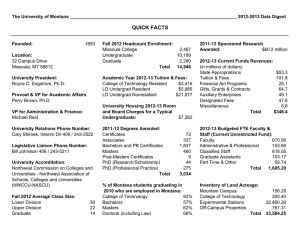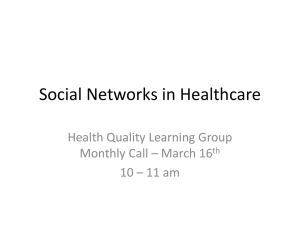advertisement
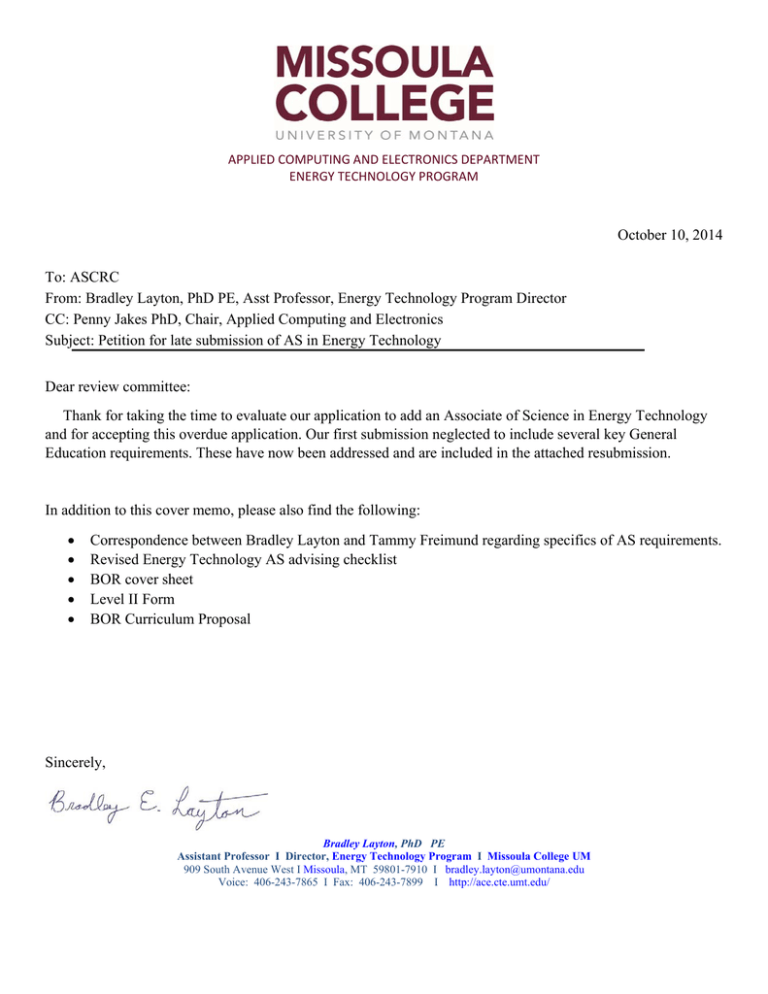
APPLIED COMPUTING AND ELECTRONICS DEPARTMENT ENERGY TECHNOLOGY PROGRAM October 10, 2014 To: ASCRC From: Bradley Layton, PhD PE, Asst Professor, Energy Technology Program Director CC: Penny Jakes PhD, Chair, Applied Computing and Electronics Subject: Petition for late submission of AS in Energy Technology Dear review committee: Thank for taking the time to evaluate our application to add an Associate of Science in Energy Technology and for accepting this overdue application. Our first submission neglected to include several key General Education requirements. These have now been addressed and are included in the attached resubmission. In addition to this cover memo, please also find the following: Correspondence between Bradley Layton and Tammy Freimund regarding specifics of AS requirements. Revised Energy Technology AS advising checklist BOR cover sheet Level II Form BOR Curriculum Proposal Sincerely, Bradley Layton, PhD PE Assistant Professor I Director, Energy Technology Program I Missoula College UM 909 South Avenue West I Missoula, MT 59801-7910 I bradley.layton@umontana.edu Voice: 406-243-7865 I Fax: 406-243-7899 I http://ace.cte.umt.edu/ Tammy and Penny, I have addressed each of the concerns that Tammy had about my original AS submission. Please find below Tammy’s original message along with my comments in bold italics. Please also find a revised advising checklist for the AS in Energy Technology. -BEL Hi Brad, • • • • • • • • • • • • Your plan does include the following General Education Requirements (GER): WRIT 101 M171 (satisfies both Mathematics requirement and Symbolic Systems) BEGEN 105S (Social Sciences Perspective) SCN 175N (Science, no lab) There are several additional GER that would be required for an AS degree: Approved Writing (WRIT 101 should satisfy) Expressive Arts (Added to Gen Ed 10-10-14) Literary and Artistic Studies (Added to Gen Ed 10-10-14) Historical and Cultural Studies (Added to Gen Ed 10-10-14 in combo with Indigenous & Global) Ethical and Human Values (Covered in BGEN 160) American & European (Covered in NRGY 101 & 102) Indigenous and Global (Added to Gen Ed 10-10-14 in combo with Hist & Cultural) Science with lab (amended 10-10-14) Other courses may count as electives. If there are technical credits in the plan, a student can use up to 20 technical credits toward an AA (and perhaps also an AS degree depending on the policy language) as long as they’ve earned an AAS. Without the AAS degree, a student can apply 15 technical credits toward an AA. If you want more detail or to see this on paper, I’ll be glad to meet up. Tammy Missoula College UM ENERGY TECHNOLOGY A.S. DEGREE Student Advising Form Spring 2015 (electronic version) Student ID: Advisor Contact Info: x7865 Advising PIN: Student Name: Advisor: Layton Entry Date: taken General Education Requirements (21 CR) Title M 171 Calculus I (Au/Sp/Su/O) BGEN 105S (BUS 103S) Intro to Business (Au/Sp/O) BGEN 160S (CCS/TASK 160S) Issues in Sustainability (Au/Sp/O) M 172 Calculus II (Au/Sp/Su/O) SCN 175N Integrated Physical Sciences I or 100-level sci (Au/Sp/S/O) 200-level Environmental Science (Au/Sp/S/O) OR 200-level physical science with lab (Au/Sp/Su/O) WRIT 101 English Composition (Au/Sp/S/O) AS Specific Requirements Expressive Arts Elective Literary and Arts Studies Course Historical and Cultural Studies (Indigenous & Global) Suggested Schedule First Year Autumn Semester BGEN 160S Issues in Sustainability CSCI 172 Intro to Computer modeling NRGY 101 Intro to Sustainable Energy I SCN 175N Integrated Physical Sciences I WRIT 101 English Composition First Year Spring Semester BGEN 105S Intro to Business ETEC 105 DC Circuit Analysis M 171 Calculus I NRGY 102 Intro to Sustainable Energy II NRGY 235 Building Energy Efficiency First Year Summer Session ETEC 113 Circuits Lab NRGY 195 Energy Practicum Second Year Autumn Semester ETEC 106 AC Circuit Analysis 200-level Environmental Science or 200-level physical sci ITS 221 Project Management M 172 Calculus II Energy Electives (see list) Second Year Spring Semester ETEC 213 (NRG 213) Power Systems Technology (Sp) ETEC 214 (NRG 214) Energy Storage & Distribution (Sp) NRGY 298 Internship (Au/Sp) Literary and Arts Studies Course Expessive Arts/ Energy Tech Electives (see list) First Year Summer Session Literary and Arts Studies Course Historical and Cultural Studies (Indigenous & Global) Cyberbear Abbreviations: BUS ‐ Business; BGEN ‐ Business: General; CCS ‐ Climate Change Studies; CSCI ‐ Computer Science/Programming; EET ‐ Electronics Technology; ENSC ‐ Environmental Science; GEO ‐ Geology; M ‐ Mathematics; NRGY ‐ Sustainable Energy; SCN ‐ Science (COT); WRIT ‐ Writing Availability: F ‐ Fall Semester; S ‐ Spring Semester; Su ‐ Summer Session; O ‐ Online; ** ‐ Online Only All coursework must be completed with a "C‐" or better to count towards your degree. CR 3 3 3 3 3 3 3 3 3 3 CR 3 3 3 3 3 15 3 4 3 3 3 16 1 2 3 Energy Core Requirements (33 CR) taken Title CSCI 172 (CRT 172) Intro to Computer modeling (Au/Sp/Su/O) ETEC 105 (EET 105/EET 111) DC Circuit Analysis (AuF/SpO) ETEC 106 (EET 106/EET 112) AC Circuit Analysis (AuO/SpF) ETEC 113 (EET 113) Circuits Lab (Su) ITS 221 (CRT 209T) Project Management (AuO) NRGY 101 Intro to Sustainable Energy I (Au/Sp/O) NRGY 102/CCS 102 Intro to Sustainable Energy II (Au/Sp/O) NRGY 195 (NRG 191) Energy Practicum (Su) ETEC 213 (NRG 213) Power Systems Technology (Sp) ETEC 214 (NRG 214) Energy Storage & Distribution (Sp) NRGY 235 (CAR 235) Building Energy Efficiency (Sp) NRGY 298 Internship (Au/Sp) Energy Electives (15 credits required) taken Title GEO 151 Fossil Fuels (Au intermittent)** NRGY 241 Alternative Fuels (Au)** NRGY 242 Solar Thermal & Wind Systems (Au)** NRGY 243 PV Design & Install (Sp)** NRGY 244 Bioenergy (Sp)** NRGY 245 Fuel Cells (Sp)** NRGY 246 Geothermal Energy Systems (Au)** NRGY 250 Energy Finance (Su)** NRGY 260 Smart Grid Technology (Sp) NRGY 270 Recycling Technology (Au) NRGY 290 Undergraduate Research (Au/Sp) NRGY 291 (NRG 295) Special Topics (Variable) NRGY 292 Independent Study (Au/Sp) NRGY 295/CCS 395 Energy Technology Practicum II NRGY 299 Energy Capstone (Au/Sp) CCS 391/NRGY 2xx Climate Change Practicum 3 3 3 3 6 18 3 3 2 3 9 20 3 3 6 My Graduation Plan Signature: Advisor: Date: CR 3 4 3 1 3 3 3 2 3 3 3 2 33 CR 3 3 3 3 3 3 3 3 3 3 3 3 var 3 3 ITEM #XXX-XXXX-XXXXX Page 1 of 1 Meeting date ITEM XXX-XXX-XXXXX Associate of Science in Energy Technology THAT The Board of Regents of Higher Education authorizes the University of Montana to add an Associate of Science degree in Energy Technology. EXPLANATION We are requesting to add an Associate of Science in Energy Technology to accommodate a growing number of incoming students with backgrounds in math, writing and science that warrant a non-terminal (AAS) degree. This student demographic is likely to consist of both traditional and non-traditional students who have their sights set on engineering or science degrees. It is also likely to consist of both local and online students who are looking for a degree in the emerging field of Sustainable Energy Technology without the financial investment required by peer or higher-ranking institutions. ATTACHMENTS • • Level II form Curriculum Proposal Revised 7/13 Level II Form Attach to full proposal for level II changes. I Summary of Proposed Changes Applied Computing and Electronics Department/program Energy Technology We are proposing to offer an Associate of Science (AS) degree in Summary Energy Technology. This is motivated by the following factors: 1) We have a growing number of students entering the Energy Technology Program with substantial mathematics and science backgrounds who are not seeking the terminal AAS we currently offer, but whom have their educational goals aimed towards a bachelor’s and/or graduate degree. By providing them with a nonterminal degree with higher math and science requirements, it is our hope that their transition to a more advanced degree will be more straightforward. 2) As Montana in general, and Missoula in particular, attempts to attract a more highly educated workforce to fill positions that might have to be filled by more qualified out-of-state candidates, we hope that by offering an AS degree, that our Energy Technology graduates will be more attractive to local employers. 3) As part of our recently funded NSF ATE we stated that this was one of the Project goals and have the expectation that we will be able to matriculate 10 – 20 students by the end of the three-year Project. II Preliminary Approval Type/Print Name Requestor: Bradley Layton Date Signature 9-18-14 Phone X7865 Department/Program Chair: Penny Jakes Other affected programs: BS Dean Lynn Stocking Dean of the Library Library impact statement: Are the resources included in the proposal sufficient to adequately support the new programs library needs? Initial Review in Provost’s Office III Type of Program Change (check X appropriate description) Create new degree; add new major to existing degree Create minor or certificate where there is no major or option in a major Change name of degree (e.g. from B.A. to B.F.A.) Any other changes in governance and organization as described in BOR policy 218, such as formation, elimination or consolidation of a college, school, department, institute, bureau, center, station, laboratory, or similar unit. YES X IV Proposal (See instructions at http://www.umt.edu/provost/policy/curriculum/default.aspx) Attach the following: √ BOR Item Template Form √ BOR Curriculum Proposal Form √ BOR Level II Request Form Revised 7/13 V Copies and Electronic Submission Submit the complete Level II proposal to the Provost’s Office for preliminary approval. After all signatures have been obtained, submit original, one copy, and an electronic file to the Faculty Senate Office, UH 221, camie.foos@mso.umt,.edu Montana Board of Regents CURRICULUM PROPOSALS ITEM #XXX-XXXX-XXXXX Page 1 of 4 1. Overview 2. Provide a one paragraph description of the proposed program. Be specific about what degree, major, minor or option is sought. We are proposing to offer an Associate of Science (AS) degree in Energy Technology. 3. Need A. To what specific need is the institution responding in developing the proposed program? This is motivated by the following factors: 1) We have a growing number of students entering the Energy Technology Program with substantial mathematics and science backgrounds who are not seeking the terminal AAS we currently offer, but whom have their educational goals aimed towards a bachelor’s and/or graduate degree. By providing them with a non-terminal degree with higher math and science requirements, it is our hope that their transition to a more advanced degree will be more straightforward. 2) As Montana in general, and Missoula in particular, attempts to attract a more highly educated workforce to fill positions that might have to be filled by more qualified outof-state candidates, we hope that by offering an AS degree, that our Energy Technology graduates will be more attractive to local employers. 3) As part of our recently funded NSF ATE we stated that this was one of the Project goals and have the expectation that we will be able to matriculate 10 – 20 students by the end of the three-year Project. B. How will students and any other affected constituencies be served by the proposed program? As stated above, this degree is being designed to serve more advanced students entering the Energy Technology Program. It is likely that we will form a partnership with the existing Pre-Engineering program as the student population for both programs is similar. C. What is the anticipated demand for the program? How was this determined? We expect there to be five to ten students who will enter the program per year. This was determined by individual advising sessions with current students who have entered the AAS Program with substantially advanced math and science backgrounds than the majority of our students. It is also our expectation that it will better serve online students such as one of our recent graduates, Michel Wallemacq, a Belgian economist who works at the Belgium Embassy in Washington DC. By offering a more advanced degree, we expect to attract more advanced students as well as a greater number of international students. 4. Institutional and System Fit A. What is the connection between the proposed program and existing programs at the institution? Since the primary differences between the AAS curriculum and the AS curriculum are in the math and science general education requirements, we expect to send more Energy Technology students Montana Board of Regents CURRICULUM PROPOSALS ITEM #XXX-XXXX-XXXXX Page 2 of 4 to courses such as calculus, physics and chemistry, the majority of which are offered on Mountain Campus. B. Will approval of the proposed program require changes to any existing programs at the institution? If so, please describe. No. C. Describe what differentiates this program from other, closely related programs at the institution (if appropriate). As stated above, perhaps the closest related program is the Pre-engineering program. The main aspects of the AS in Energy Technology that differentiate it from pre-engineering is that the ASET offers more technology-specific coursework. D. How does the proposed program serve to advance the strategic goals of the institution? 1. This certificate will strengthen Missoula College ties with the University of Montana by exposing a greater number of Missoula College students to the mathematics and science courses taught within the College of Humanities and Sciences as we “Partner for Student Success,” by preparing them for 4-year degrees as well as graduate degrees. 2. This degree will also provide a pathway towards “Education for the Global Century” which promised to require greater technical skills and within the context of liberal education. 3. By equipping our Energy Technology students with the tools of calculus and the concepts inherent in the physical sciences in conjunction with the many hands-on learning experiences for students pursuing this degree, we will create a more “Dynamic Learning Environment.” By providing this new two-year degree option for students, it will allow us to fine-tune and diversify the Energy Technology Program as part of its “Planning-Assessment Continuum.” E. Describe the relationship between the proposed program and any similar programs within the Montana University System. In cases of substantial duplication, explain the need for the proposed program at an additional institution. Describe any efforts that were made to collaborate with these similar programs; and if no efforts were made, explain why. If articulation or transfer agreements have been developed for the substantially duplicated programs, please include the agreement(s) as part of the documentation. The only similar program is the AAS in Energy Technology currently offered at Missoula College. We are already partnered with other two-year colleges through our current DOL TAACCCT SWAMMEI project and have made every effort to invite our consortium colleagues to encourage their students to enroll in our diverse course offerings. 5. Program Details A. Provide a detailed description of the proposed curriculum. Where possible, present the information in the form intended to appear in the catalog or other publications. NOTE: In the case of two-year degree programs and certificates of applied science, the curriculum should Montana Board of Regents CURRICULUM PROPOSALS ITEM #XXX-XXXX-XXXXX Page 3 of 4 include enough detail to determine if the characteristics set out in Regents’ Policy 301.12 have been met. The Associate of Science degree in Energy Technology is designed to be a non-terminal degree for students wishing to pursue a Bachelor of Science degree or higher. Students in the Energy Technology Program are introduced to the full suite of energy sources and technologies. Graduates will be practitioners that are equipped with skills in design, installation, and maintenance of diverse energy technologies and systems; sales, operations, and management; regulatory compliance; basic electricity and power systems; energy storage and distribution; site assessment; basic energy economics; efficiency and conservation strategies; and project management. With its more rigorous STEM requirements, students are prepared to enter engineering programs. Students may enter the program in either autumn or spring term. B. Describe the planned implementation of the proposed program, including estimates of numbers of students at each stage. We propose to begin offering this degree Autumn 2016 with an expected enrollment of approximately five students. Our anticipation is that we will enroll between five and ten students per year thereafter. 6. Resources A. Will additional faculty resources be required to implement this program? If yes, please describe the need and indicate the plan for meeting this need. No. Missoula College students who have sufficient math and science skills will take their Gen Ed math and science courses on Mountain Campus or online where possible. B. Are other, additional resources required to ensure the success of the proposed program? If yes, please describe the need and indicate the plan for meeting this need. No. 7. Assessment How will the success of the program be measured? We will measure success by enrollment, retention, matriculation, and employment statistics. We are also optimistic that by partnering more strongly with the College of Humanities, Arts and Sciences that we will continue to build upon the improving relationship between Missoula College and The University of Montana. 8. Process Leading to Submission Describe the process of developing and approving the proposed program. Indicate, where appropriate, involvement by faculty, students, community members, potential employers, accrediting agencies, etc. Montana Board of Regents CURRICULUM PROPOSALS ITEM #XXX-XXXX-XXXXX Page 4 of 4 This degree program was discussed extensively with Cathy Corr as well as other Associate of Science committee members. It has also been discussed with ASCRC members and reviewed and approved by a National Science Foundation Advanced Technology Education review committee.
